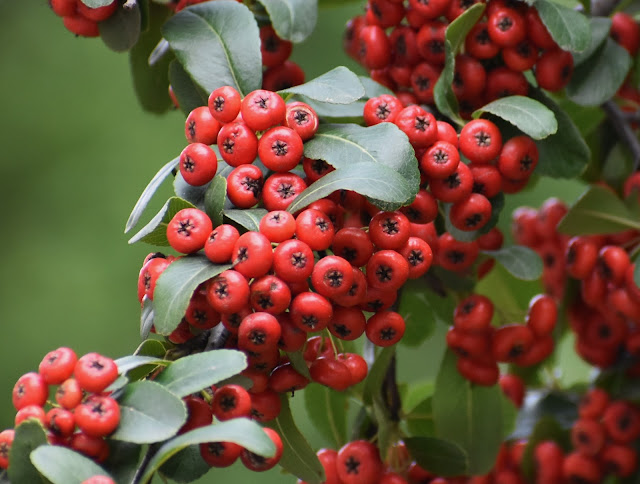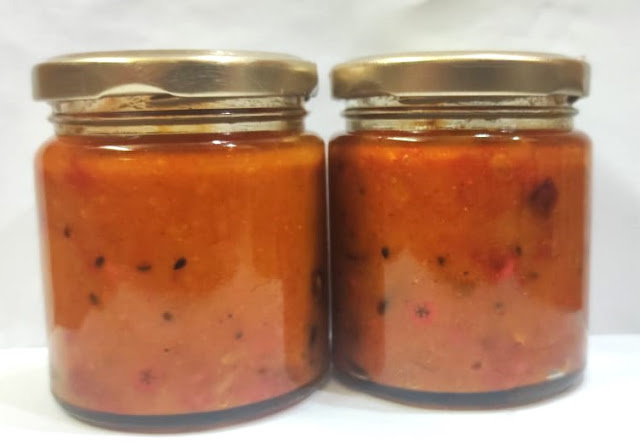God's treasure contains vastness in the sky, unfathomable depths in water and mysterious gems and diamonds in its nature. The Himalayan firethorn (also known as Nepalese white thorn or Nepalese firethorn) is one such beautiful thorny evergreen hidden shrub in nature's lap. Commonly known as Ghingaru, Gangharu or Chhota Seb in India, it is a rare combination of a plant with natural beauty and value. Botanically known as Pyracantha crenulata (synonym- Crataegus crenulata), it belongs to the rose family (Rosaceae) and is variously used in its native necks of the woods.
DISTRIBUTION
Himalayan firethorn is found naturally in India, Nepal, China, Myanmar, and Bhutan. In India, it is mainly distributed in Jammu & Kashmir, Himachal Pradesh, and Uttarakhand, however, it has been used as an ornamental hedge in many countries of the world. It is commonly found in shrubberies, on open slopes, along stream sides and in grassy places at an altitude ranging from 900 to 2400 metres above the mean sea level.
A branch with leaves and flowers
MORPHOLOGY
Himalayan firethorn is a thorny shrub growing to a height of approximately 5 m. The stem is profusely branched and has thorns distributed all over it. The branches are dark brown in colour when old. Leaves are simple and each leaf is differentiated into a petiole and leaf blade. The petiole is small and glabrous. The leaf blade is dark green in colour, oblong or oblanceolate in shape and 2-7 × 0.8-1.8 cm in size. Both the leaf surfaces are glabrous in texture. The leaf margin is crenulate or sparsely so, the leaf base is broadly cuneate or slightly rounded and the leaf apex is acute or obtuse. White flowers are arranged in dense compound corymbs of 3-5 cm diameter with caducous bracts. Flowers are 6-9 mm in diameter with typical rosaceous architecture and campanulate hypanthium. Sepals are greenish-brown, triangular, 1–1.2 mm in size and abaxially glabrous. Petals are white, orbicular, 4-5 × 3-4 mm in size with rounded apex. Stamens are approximately 20 in number per flower. The ovary is densely white and pubescent apically. Fruit is a nearly globose pome which is green initially but turns red or orangish at maturity. Flowering occurs from March to May and the fruits mature from August to November.
A shrub with ripe pomes (fruits)
CHEMICAL CONSTITUENTS
Himalayan firethorn contains β-carotene, β-sitosterol, alkaloids, amino acids, carbohydrate, catechin, chlorogenic acid, cis-3, 4-dioxyethylene-5- methoxycinnamic acid, delphidin, ellagic acid, esculatin, ferrulic acid, flavonoids, gallic acid, glycosides, hydroxybenzoic acid, lanost-54-en-2β, 3β-diol 26-oic acid, lycopene, m-coumeric acid, oligomeric proanthocyanidins, polyphenols, phenyl ethylamine, proteins, pyracrenic acid, quercetin, rutin, sterols, tannins, terpenoid, vitamins, etc. (Bhatta et al., 2021, Kewlani et al., 2023).
Harvested fruits
I. MEDICINAL USES
Himalayan firethorn is found commonly in the Himalayan region, but people really do not know the real worth of this elixir shrub, which has the following medicinal uses:
1. Good for Heart: Fruits of Himalayan firethorn are used as a heart tonic to treat myocardial debility in many traditional systems of medicine in the Himalayas. Defence Agricultural Research Laboratory Haldwani has developed HRIDAYAMRIT: A Herbal Health Beverage using the fruits of this plant.
Photo source: Defence Agricultural Research Laboratory, Haldwani (DRDO)
2. Relieves Constipation: Fruits of Himalayan firethorn are considered to be useful in curing constipation.
3. Heals the Burns: Leaf paste can be used to heal the burns.
4. Suppresses Formation of Kidney Stones: Fruit juice is reported to suppress stone formation in kidneys in animal models.
5. Anti-Inflammatory Activity: The fruits of Himalayan firethorn are rich sources of flavonoids and anthocyanin which have significant anti-inflammatory activities.
6. Antihypertensive Properties: The fruits of Himalayan firethorn are reported to have antihypertensive activity in animal models.
7. Antimicrobial Activity: The fruit extract of Himalayan firethorn is reported to have anti-microbial activity against Escherichia coli, Salmonella typhimurium, Klebsiella pneumonia, Bacillus subtilis, Pseudomonas aeriginosa, and Streptococcus pyogenes.
8. Antioxidant Activity: Fruits of Himalayan firethorn contain many phytochemicals which have strong antioxidant activity.
9. Pain Management: Himalayan firethorn is traditionally used for the treatment of joint and body aches in the Kumaon region of Uttarakhand. A recent experimental study in 2023 (Tiwari et al., 2024) has scientifically proved the analgesic properties of this plant.
II. CULTIVATION AS AN ORNAMENTAL
Himalayan firethorn plants can be cultivated as ornamental hedging plants as they bear beautiful red- or orange-coloured fruits that persist for 2-3 months on the shrubs. These shrubs can also be trained in several ways to prepare eye-catching structures such as arches, circles, cones, bonsai, etc.
Himalayan firethorn hedge
Photograph courtesy: Dr. Puja Sharma, Dr. Bharati Kashyap and Dr. S.R. Dhiman
III. EDIBLE USES
The fruits of Himalayan firethorn are edible as the fruits of other Rosaceous plants such as apples, quince, pear, loquat, strawberries, peaches, apricots, raspberries, etc. The birds also relish these fruits. However, care should be taken not to eat the seeds which are mildly toxic. Various value-added products such as jam, chutney, preserves and choco shots have been developed by the Department of Food Science & Technology, Dr. Y.S. Parmar University of Horticulture & Forestry, Nauni (Solan), Himachal Pradesh using the fruits of this valuable plant. The deseeded fruits can also be mixed in shake and custard.
Himalayan firethorn jam
(Photograph courtesy: Shlok, Dr. Rakesh Sharma and Dr. Bharati Kashyap)
Himalayan firethorn preserve
(Photograph courtesy: Shlok, Dr. Rakesh Sharma and Dr. Bharati Kashyap)
Apricot and Himalayan firethorn chutney
(Photograph courtesy: Shlok, Dr. Rakesh Sharma and Dr. Bharati Kashyap)
TOXICITY
Himalayan firethorn belongs to a family where the leaves and seeds of many members contain small quantities of hydrogen cyanide which imparts a bitter taste to the plant parts. Although hydrogen cyanide stimulates respiration and improves digestion in small quantities, it can cause respiratory failure and even death in high quantities (Plants for a Future, 2023).
REFERENCES
- Bahuguna, Y.M., Rawat, M.S.M., Juyal, V. and Gusain, K. (2009). Evaluation of Pyracantha crenulata Roem for antiurolithogenic activity in albino rats. Afr. J. Urol. 15 (3): 159–166.
- Bhatta, G.D. Kunwar, R.M. and Bussmann, R.W. (2021). Pyracantha crenulata (D. Don) M. Roem. In: Ethnobotany of the Himalayas, Ethnobotany of Mountains. Edited by: Kunwar, R.M. and Bussmann, R.W. Springer Nature Switzerland.
- Kewlani, P., Negi, V.S., Bhatt, I.D. and Rawal, R.S. (2023). Pyracantha crenulata (Roxb. ex D.Don) M.Roem. In: Himalayan Fruits and Berries: Bioactive Compounds, Uses and Nutraceutical Potential. Edited by T. Belwal, I.D. Bhatt, and H.P. Devkota. Academic Press (An imprint of Elsevier), USA.
- Negi, P.S., Singh, R., Dwivedi, S.K. (2018). Evaluation of antihypertensive effect of fruit beverage of Crataegus crenulata Roxb.: A wild shrub of Himalayan hills. Def. Life Sci. J. 3, 146–150.
- Plants For A Future (2023). Pyracantha crenulata - (D.Don.)M.Roem. Accessed on 27th August 2023 at https://pfaf.org/user/Plant.aspx?LatinName=Pyracantha+crenulata
- Tewari, D., Bawari, S., Sah, A.N., Sharma, H., Joshi, B.C., Gupta, P. and Sharma, V.K. (2024). Himalayan Pyracantha crenulata (D.Don) M.Roem. leaf and fruit extracts alleviate algesia through COX-2 and Mu-opioid receptor mediated pathways. J. Ethnopharmacology 318 (Part B): https://doi.org/10.1016/j.jep.2023.117004













%20(1).jpg)
